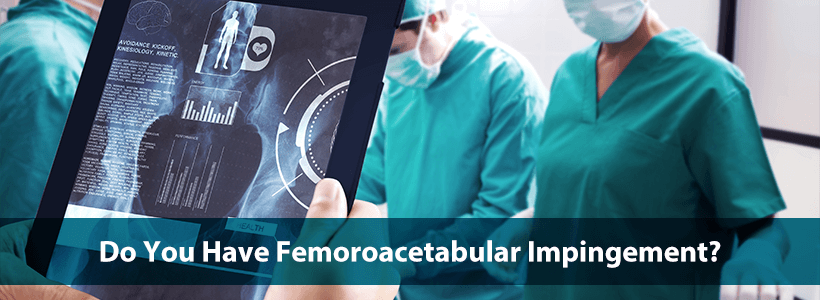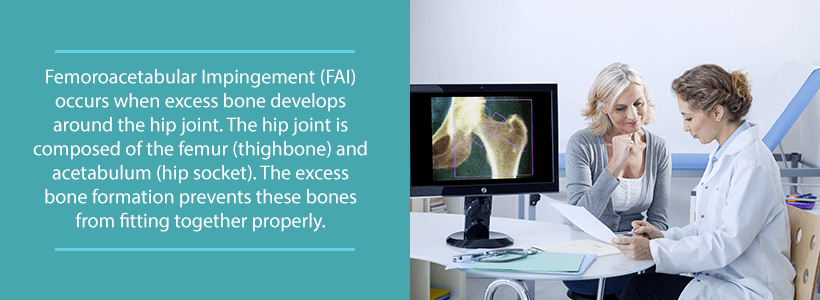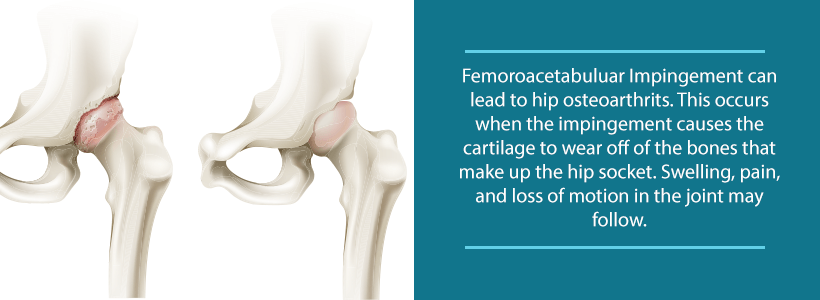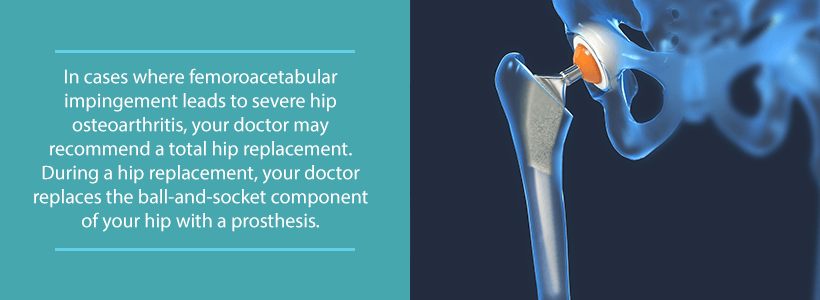If you’re dealing with frequent back or neck pain, your posture might be playing a bigger role than you think. Whether you're sitting at a desk all day or scrolling on your phone for hours,…
Are you suffering from pain in the groin or hip area? Hip pain can result from a variety of injuries or conditions. Understanding what causes your discomfort is often the first step in treating symptoms and preventing future injuries.
Femoroacetabular Impingement (FAI) occurs when extra bone develops on or near the hip joint. Sometimes referred to osteophytes or bone spurs, these growths can disrupt the movements of the hip bones. Over time, the friction generated by these bone spurs can damage the joint and limit your activity.
How do you know if you have FAI? Let’s take a closer look at the hip joint and how this condition affects your hips. Then, we’ll look at the best treatment options to reduce pain and restore function to the area.
Understanding the Hip Joint
The hip joint is one of the largest joints in the body. It also plays a key role in weight-bearing activities. Walking, running, and other vigorous activities can apply a lot of stress to the joints. Luckily, a healthy hip can support your weight, easily withstanding these stressors. Disease and injury, however, can alter the hip structure which, in turn, affects its function.
The ball-and-socket joint of the hip connects two bones—the thigh bone (femur) and the pelvis. The round femoral head fits snugly into a “socket” known as the acetabulum. Think of the acetabulum as a cup-shaped structure and the femoral head as slightly more than half a sphere. A smooth layer of articular cartilage covers the bones in the joint. The body produces synovial fluid to keep the cartilage slippery so the bones can move past each other without damage. Another ring of strong cartilage—known as the labrum—lines the outer edge of the acetabulum. The labrum deepens the joint, allowing for enhanced range of motion and joint alignment.
In addition, a series of ligaments and muscles hold the hip joint in place, delivering stability. Some of the strongest ligaments in the body are located at or near the hip joint. Muscles allow the bones associated with the hip to bend, straighten, rotate, and move the leg to and away from the midline.
What is Femoroacetabular Impingement?
FAI occurs when abnormal bone growths form around the femoral head or acetabulum. However, the exact cause of FAI is unknown. It’s believed that genetics and pediatric hip diseases, like coxa vara or Legg-Calve-Perthes disease, increase the likelihood of developing FAI. Additionally, participating in high-impact sports such as hockey or basketball during adolescence may play a role. Sports, however, do not seem to cause FAI. They simply hasten the onset and severity of the symptoms.
Furthermore, hip impingement can occur in three different ways:
- Pincer Impingement: Occurs when the bone growth extends over the rim of the acetabulum. As a result, the labrum may become damaged.
- Cam Impingement: Occurs when a bump forms on the femoral head. When the head loses its typical round shape, it cannot move smoothly around the inside of the acetabulum.
- Combined Impingement: As the name suggests, this is when growths are found on both the femoral head and the acetabulum.
Symptoms of Femoroacetabular Impingement (FAI)
In minor cases, some individuals may not even realize that they have FAI. In fact, people with FAI can live normal, active lives without experiencing much discomfort. However, others can gradually develop symptoms when damage to the surrounding soft tissues occurs. Symptoms of FAI include:
- Stiffness in the groin, hip, or thigh
- Groin or hip pain—especially after running, exercising, or sitting for extended periods of time
- Difficulty flexing the hip beyond a right angle
- Reduced range of motion including difficulty flexing, rotating, and adducting the hip
- Painful locking, clicking, or instability related to labral tearing
In addition, the damage caused by FAI may also lead to hip osteoarthritis. This occurs when the impingement causes the cartilage to wear off the bones in the hip socket. Likewise, the rubbing together of bones causes swelling, pain, and loss of motion in the joint.
Diagnosing Femoroacetabular Impingement (FAI)
If you’re experiencing symptoms like those discussed above, you may want to get checked out by a doctor. Several other conditions cause similar symptoms, including hip pain. Pinpointing the exact cause of your hip pain makes treating it much more effective.
A doctor’s visit usually begins with a full review of your medical history and overall health. This includes discussing current and previous occupational or recreational activities that may have contributed to your hip condition.
If FAI is suspected, the doctor generally performs an impingement test. The doctor conducts this test while you lie on your back. Your knee is brought to your chest and gently rotated toward your opposite shoulder. If you feel pain or it recreates your symptoms, you may have FAI.
Diagnostic Testing
In addition to a general exam and impingement testing, the doctor may order diagnostic imaging to obtain a better view of the area. These tests can include:
- X-rays and computed tomography (CT) scans: Images that allow the doctor to see any abnormalities in your hip joint. CT scans also help doctors to obtain a detailed view of the joint structure.
- Magnetic resonance imaging (MRI) scans: By using a magnetic field and radio waves, this test allows the doctor to observe any damage to the articular cartilage and labrum.
Getting Help for Your Femoroacetabular Impingement (FAI)
Once diagnosed with FAI, both conservative and surgical options are available to relieve symptoms and restore joint function.
Conservative Treatments for FAI
Physical therapy (PT) offers several benefits for individuals who suffer from FAI. Exercise-based physical therapy programs can reduce disability by focusing on muscle strength and flexibility. PT also assists with restoring your range of motion. In addition, a physical therapist can provide education about activity modification, movement pattern retraining, and pain management.
A non-steroidal anti-inflammatory medication, like ibuprofen, can also alleviate pain and inflammation. Depending on your discomfort, the doctor may prescribe pain medications. Always take these as directed as they can become addicting.
Surgical Options for FAI
The goal of FAI surgery is to correct the abnormalities caused by FAI and repair any damaged soft tissues. Surgical options can include:
- Hip Arthroscopy: This minimally invasive surgery uses a tiny camera and surgical tools. These tools allow the surgeon to remove the bone spurs caused by FAI. The surgeon will also repair damage to the articular cartilage and labrum. Hip arthroscopy is the most common surgery for those who suffer from FAI.
- Hip Replacement: If your FAI has caused severe hip osteoarthritis, a total hip replacement may be necessary. Those who are not good candidates for hip arthroscopy may benefit from a hip replacement. While this surgery is more complicated, the outcomes generally eliminate or decrease symptoms and restore function.
As surgical techniques and technologies improve, the reliance on minimally invasive surgery will only increase. Since minimally invasive surgery only requires small incisions, this means less scarring, damage to soft tissues, and blood loss. As a result, you can also recover faster from hip surgery with less preoperative pain.
Ready for an Experienced Team to Help You?
Dealing with hip pain can keep you from doing the things you love. Instead of being sidelined with FAI, maybe it’s time you consulted with a team of doctors who are ready to pinpoint the source of your pain and empower you with the best treatment options.
Our experts at Orthopedic & Laser Spine Surgery will take the time to get to know you, your symptoms, and goals for treatment. We work with you to create a treatment plan geared toward your individual needs and preferences.
Using the latest technology and medical advances, we treat your conditions to ensure accuracy and successful outcomes. Are you ready to take care of your hip pain and return to the things you love? Schedule a consultation with Orthopedic & Laser Spine Surgery today to see how we can help.




